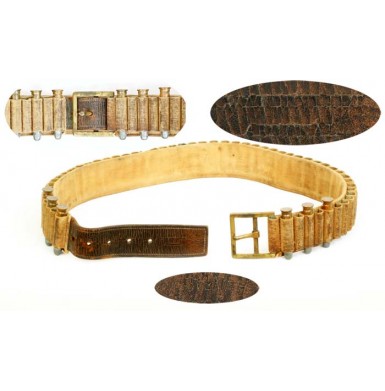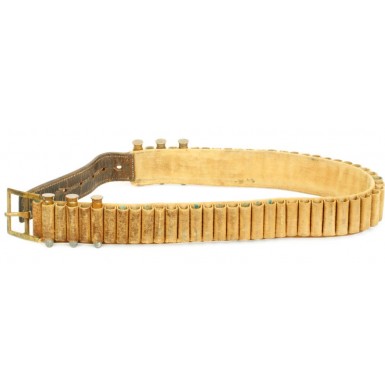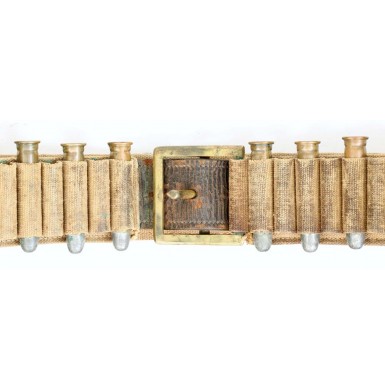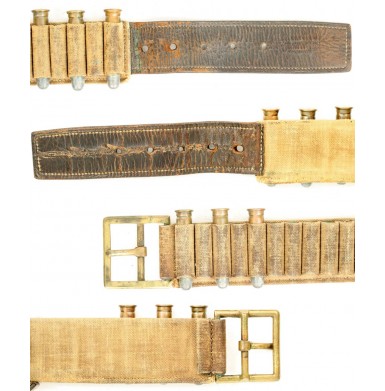1876 Cartridge Belt - Very Rare Narrow Variant
- Product Code: ALKH-1328-SOLD
- Availability: Out Of Stock
-
$1.00
In 1876 the US Ordnance Department finally succumbed to the pressure from the troops in the field and began production of the first official US military cartridge belt. From this first belt would spring a variety of looped cartridge belts that would carry ammunition for US soldiers in the field for the next three decades. The concept of the cartridge belt was hardly new, and from the advent of metallic cartridges, a variety of field modifications and designs had been in use by US soldiers on an unofficial basis. Often the belt was simply a modified issue belt with cartridge loops added by the saddler or some other soldier with leatherworking or sewing skills. The belts were particularly popular with soldiers serving on the frontier, and the applied loops were sized to accept the ammunition that was in use at that station, whether it was .52-56 Spencer, .44 Henry or the later .50 RF Government cartridges. While not officially sanctioned, these modified belts were usually accepted by company and regimental officers as useful and effective methods of carrying ammunition in the field, and as such were tacitly approved. The carrying of early metallic cartridges in the field was problematic, as the cases were made of soft copper rather than the stiffer brass of later era cartridges. This meant that the casings were easily damaged in handling and carry. The standard method of carrying cartridges was the cartridge box, but it was soon discovered that loose rounds in a cartridge box that was roughly handled could be damaged enough to make them unusable, and in extreme cases could cause the detonation of rimfire cartridges! The obvious solution was the cartridge belt, which used loops to carry the ammunition individually and provided a great level of protection for each cartridge. The downside was that the cooper casings rapidly developed verdigris when exposed to the leather of the cartridge loops, and this green oxidation could bind the cartridge to the loops and even make the cartridges difficult to chamber in the weapon. In extreme cases, those oxidized cartridges could be almost impossible to extract from the chamber after they were fired. As a result of the advantages and disadvantages offered by both the cartridge box and cartridge belt, forces within the Ordnance Department continued to argue which system would be the most effective and efficient. In the decade immediately following the Civil War, the debate influenced by the huge number of surplus accoutrements on hand, resulting in the continued official use of the cartridge box, usually a Civil War era box that had been modified in some way. The men in the field, however, particularly on the western frontier, continued to make their own cartridge belts, and often with the support of their officers. As a result, US Ordnance Department adopted the Model 1876 Cartridge Belt (often referred to as the Prairie Belt) in that year, and the belt went into production at the Watervliet Arsenal in New York in the latter part of that year. The belt was authorized for use by both the cavalry and infantry and 2,500 of the new pattern cartridge belt were manufactured. The new belt design resolved the verdigris problem by being produced of varnished canvas rather than leather. The folded canvas belt had fifty-four cartridge loops sewn to it and had a two-layer tongue made of bridle leather. A square brass framed buckle was sewn to one end of the fabric belt and its brass prong engaged one of the holes in the leather tongue for sizing adjustment. The new belt was 2” wide, with 1 ““ cartridge loops with a 1 ““ wide leather tongue with five adjustment holes in it. Stephen Dorsey’s American Military Belts and Related Equipments places the overall length of the 1876 Prairie Belt at 42”, although it seems that some variation was not uncommon. While Dorsey notes that many belts were subsequently modified and shortened by the troops in the troops in the field, these modifications are usually easily detectible. Collectors now refer to these first 2,500 Model 1876 Cartridge Belts as the “Narrow Belt Variation”, as all of the subsequent belts of this pattern that were produced were wider with a 2 9/16” wide belt body and longer cartridge loops that were 2” in length. The wider belt and longer loops were probably adopted to further protect the cartridges, as the initial belt design allowed a significant amount of the cartridge to be exposed above or below the loop. These later “Wide Belt Variation” cartridge belts would remain in production and use until 1881 and the adoption of the woven Mills patent cartridge belt. Significantly more of the wide belts were made than the early narrow belts and due to the canvas construction, heavy field use and simple attrition, the early production narrow belts are extremely scarce today and are highly prized by Indian War collectors as the first official cartridge belt, which went into production the same year as the Custer massacre at the Little Big Horn, and would see significant use during the height of the Indian Wars on the western frontier.
Offered here is a VERY GOOD+ to NEAR FINE condition example of the very scarce Model 1876 Cartridge (Prairie) Belt Narrow Belt Variation. This is one of the rarely encountered 2” wide belts that was part of the initial production of only 2,500. As noted the belt body is 2” wide with fifty-four 1 ““ wide .45 cartridge loops. The belt measures 40 ““ in overall length, with the belt body (not counting the buckle) measuring 38 5/8”, including the 7 ““ long and 1 ““ wide leather tongue. While the overall length of the belt is 1 ““ short of the regulation 42”, there is no indication that this belt has been modified or shortened in any way. The leather tongue appears to be its original length with no trimming and the stitching appears to be 100% original with no alteration. The front of the leather tongue is marked in two lines WATERVLIET / ARSENAL and the very tip of the tongue is marked A R SMITH, who was an inspector at that arsenal. The Watervliet mark remains quite legible, but the A.R. Smith mark is somewhat harder to read. As noted the belt is in about VERY GOOD+ to NEAR FINE condition. The belt remains 100% complete, correct and original, and is still quite solid and strong. The belt shows significant staining and discoloration to the varnished canvas as a result of wear, use and age. There is also some verdigris staining on the belt as well, primarily on and in the cartridge loops. The belt fabric remains solid and complete with no rips or tears and all of the stitching appears to be original, remaining tight and secure. The cartridge loops remain in similarly solid condition, although a few of them show some light fraying and wear around the mouths where the cartridges are inserted and removed. The leather tongue appears to be full length and unaltered and remains solid and pliable. The leather retains much of its original finish, but also shows significant crazing, flaking and finish loss, particularly on the rear, where the prong from the buckle has worn a line along the interior of the tongue. All of the stitching in the double layer tongue remains original, is mostly tight and secure. The brass frame buckle is also original and has really gorgeous, untouched and uncleaned rich ocher patina. The buckle functions perfectly and allows the belt to be secured as it should. Six original, Indian War era Benet Primed (inside primed) .45-70 cartridges are included with the belt for display. The cartridges are headstamped F and R, indicating “Frankford Arsenal” and “Rifle”. The cartridges were all made in 1881, and are marked 81, and have varying month dates, including 5, 6, 8 and 12. The cartridges all have a nice, rich, uncleaned patina on the copper cases and a dull gray patina on the lead bullets, with patches of white oxidation. The cartridges really enhance the display of the belt and also make it obvious that it is the rare, “narrow” belt, as they extended so much farther beyond the top and bottom of the cartridge loops than on the later version of the belt.
Overall this is a VERY GOOD+ to NEAR FINE condition example of a very scarce Model 1876 Cartridge (Prairie) Belt Narrow Belt Variation. The belt is 100% complete, correct and original and is in very usable condition. The maker and inspection marks on the tongue remain legible and the belt has a wonderful “used but not abused” look, allowing it to display wonderfully. With only 2,500 of these belts manufactured, they rarely appear for sale on the market. When they do are usually in rough condition and priced well in excess of $1,500. This belt is one of the nicest examples that I have ever seen and is priced below the $1,500 price point. The belt also includes six very nice Indian War era Frankford Arsenal .45-70 cartridges from 1881, and these cartridges typically retail in the $30-$40 range for each cartridge. That means you get about $200 worth of collector cartridges with the belt at no additional charge. For any serious Indian War collector this is the most desirable and most difficult cartridge belt to acquire and most never even have the opportunity to purchase one. This one is in really wonderful condition, includes some great original cartridges and is priced very fairly. I am sure that you will be very proud to add this wonderful belt to your Indian War collection and I know it will display wonderfully.






